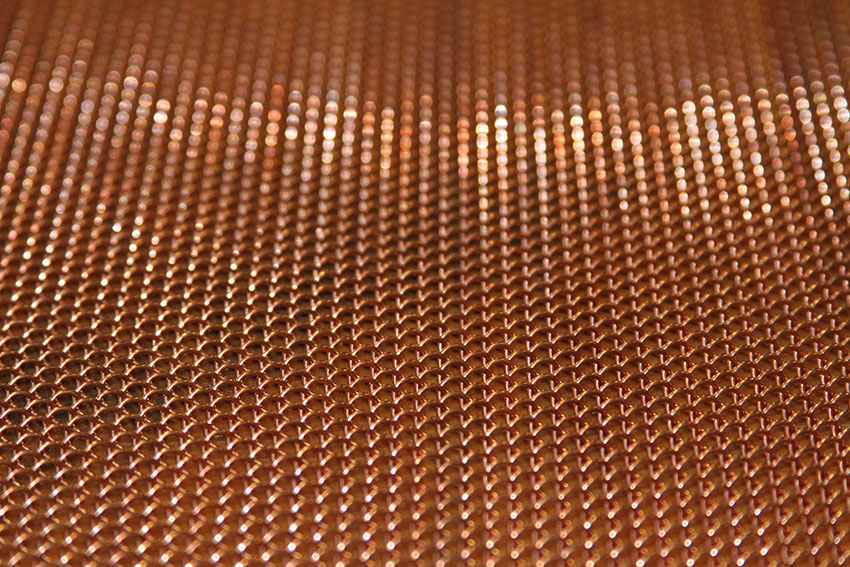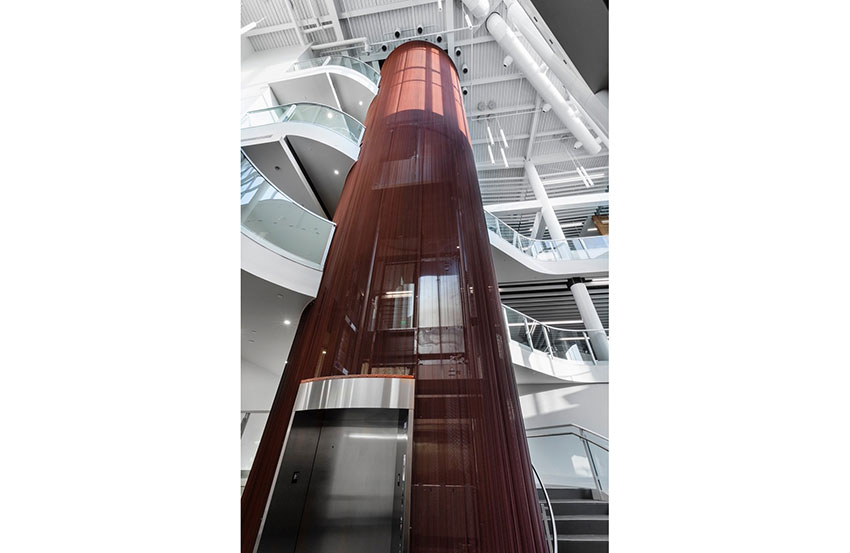It’s a Material Thing
Certified Benefits of Coiled Wire Fabric
Coiled wire fabrics also provide significant building performance and environmental benefits. Independent testing shows reduced energy consumption by up to 3.3% for interior window and glazing applications. When located to the exterior, independent testing shows reduced energy consumption by up to 12.3%. Coiled wire fabric is also an effective product for retrofit projects where high-performance glazing has not been installed.
With reduced energy consumption comes a significant increase in the thermal comfort of occupants in both interior and exterior applications. Thermal comfort is enhanced by mitigating the effects of direct sunlight and cooling down spaces. Coiled wire fabrics also create increased visual comfort and minimize glare without reducing views and illumination.
Besides third-party verification of energy savings and thermal comfort, certain coiled wire fabric products have been independently assessed for health metrics. Superior products will be certified as Living Building Challenge Red List Free and may have a Declare label with the International Living Future Institute. These certifications provide the certainty that no harmful materials are being introduced with a product. They also demonstrate that no toxic chemicals are used in the manufacturing process. The best manufacturing process uses minimal energy, no toxic chemicals or solvents, and produces almost no scrap. Eco-friendly powder coatings should be specified, containing no solvents and emitting negligible, if any, polluting VOCs. As an added benefit, these powder coatings can be recycled and reused, generating zero hazardous waste, and rendering the certified woven fabric product 100% recyclable. This also ensures a low carbon footprint, enhanced by wire that is domestically sourced, durable, and easy to maintain. Natural wire finishes that require no painting are preferred, as these introduce no VOCs.
Maintenance is another important piece of the IEQ puzzle. A product that needs heavy upkeep and cleaning introduces additional chemicals and solvents into the indoor environment. Coiled wire fabric is low maintenance. The powder coated and low-VOC clear lacquer finishes will not fade or darken, and the material tends to shed dust. Coiled wire fabric is also naturally flameproof, has a low life-cycle cost, and is ideal for public area applications due to its superior strength.

Photo courtesy of Cascade Architectural
Coiled wire fabrics are available with a range of attachment systems, allowing for different building conditions and finish treatments.
Using Third-Party Certification As A Design Tool For Health Goals
As defined by the National Institute for Occupational Safety and Health (NIOSH), indoor environmental quality (IEQ) refers to the quality of a building’s environment related to the health of occupants within it.3 IEQ is determined by many factors, including lighting, air quality, and damp conditions. The influences on indoor environments are incredibly complex and varied. Occupant health can be affected not only by dampness and ventilation in the building, but also by contaminants emitted from products within the building.
This includes building materials, carpets and furnishings, and even cleaning products. Understanding the sources of indoor environmental contaminants and controlling them can help prevent or resolve building-related symptoms in workers, according to the Centers for Disease Control and Prevention (CDC).
When making decisions for the health of a building and its occupants, look for products that are transparent and supported with life-cycle assessment documentation. Product transparency means that all relevant product information is fully and freely available to the public. This disclosure and accountability helps designers, specifiers, and end-users make informed purchasing decisions about which materials should be placed in buildings.
The Declare Label
The International Living Future Institute (ILFI) Declare certification creates a process for disclosing product ingredients in a transparent way, allowing manufacturers an opportunity to provide a clear list of materials in each building product. By facilitating and simplifying the exchange of complex ingredient information, Declare’s stated goal is to positively change the materials marketplace to enable the creation of buildings that support human and environmental health.4 For designers, the Declare product database streamlines material specification and certification for sustainable design.
Manufacturers voluntarily disclose all product information on Declare labels, which have a user-friendly format. These labels report all product ingredients and use a simple color code system to flag any chemicals of concern. Declare labels disclose all intentionally added ingredients and residuals at, or above, 100ppm (0.01%) present in the final product by weight. Each ingredient must be reported with a chemical name, Chemical Abstract Services (CAS) number, and percentage or percentage range. Further information is provided on the product’s final assembly locations, life expectancy, end-of-life options, and overall compliance with relevant requirements of the Living Building Challenge (LBC).
An active Declare label with a status of LBC Red List Free, LBC Red List Approved, or LBC Compliant at the time of specification is sufficient documentation of product compliance with I13 Red List. The Living Building Challenge (LBC) Red List represents the “worst in class” materials, chemicals, and elements. These ingredients are known to pose serious risks to human health and the greater ecosystem and, unfortunately, are prevalent in the building products industry. The ILFI believes that these materials should be phased out of production due to human and environmental health and toxicity concerns. ILFI worked with the Healthy Building Network and the Pharos Project to develop the original Red List in 2006.
All active Declare labels are accessible on a free and searchable database. The database is used by designers, large real estate owners, and homeowners to specify trusted products. The Declare label also demonstrates alignment with other requirements within the Living Building Challenge and Core Green Building Certification as well as LEED and WELL certifications. These requirements include ingredient disclosure thresholds, VOC content and emissions, embodied carbon, and responsible sourcing, including FSC Chain of Custody.











